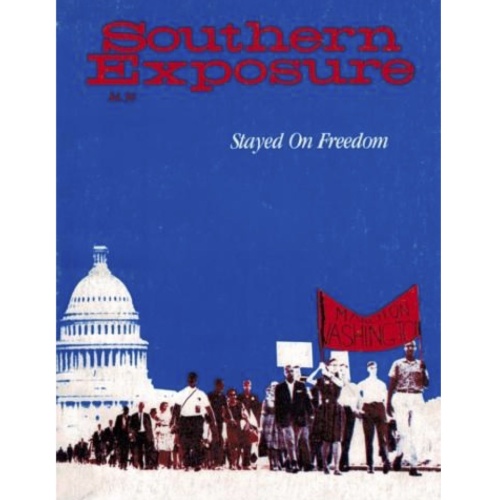From the Archives: Lies Across the South
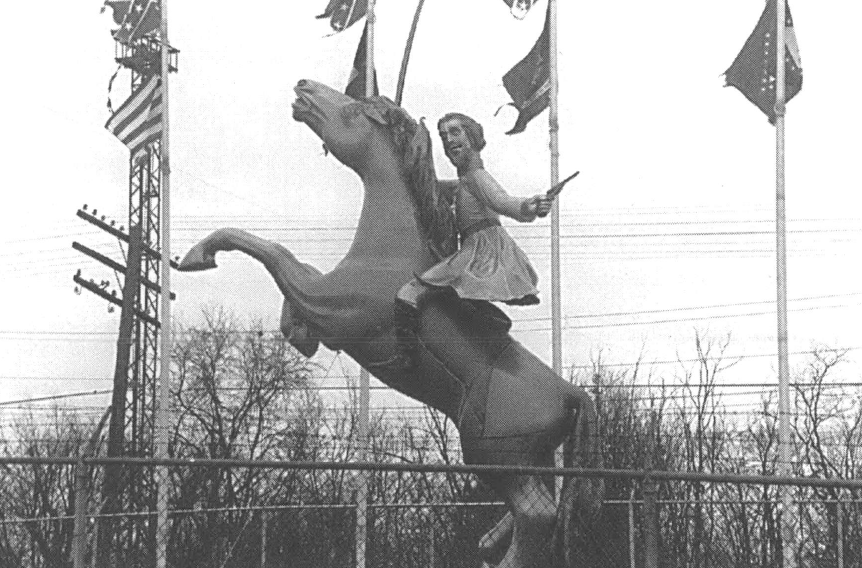
In July 1998, the League of the South dedicated a big new statue of Nathan Bedford Forrest, a Confederate Army general and the first Grand Wizard of the Ku Klux Klan, at a "Confederate Flag Park" on private property south of Nashville, Tennessee. (Photo by James Loewen)
People's historian James W. Loewen died from cancer this month at age 79. An Illinois native, he attended Mississippi State University and earned a doctorate in sociology from Harvard with a dissertation on Mississippi's Chinese American community. He went on to teach at historically Black Tougaloo College in Jackson, Mississippi, as well as at predominantly white University of Vermont and Catholic University of America in Washington, D.C.
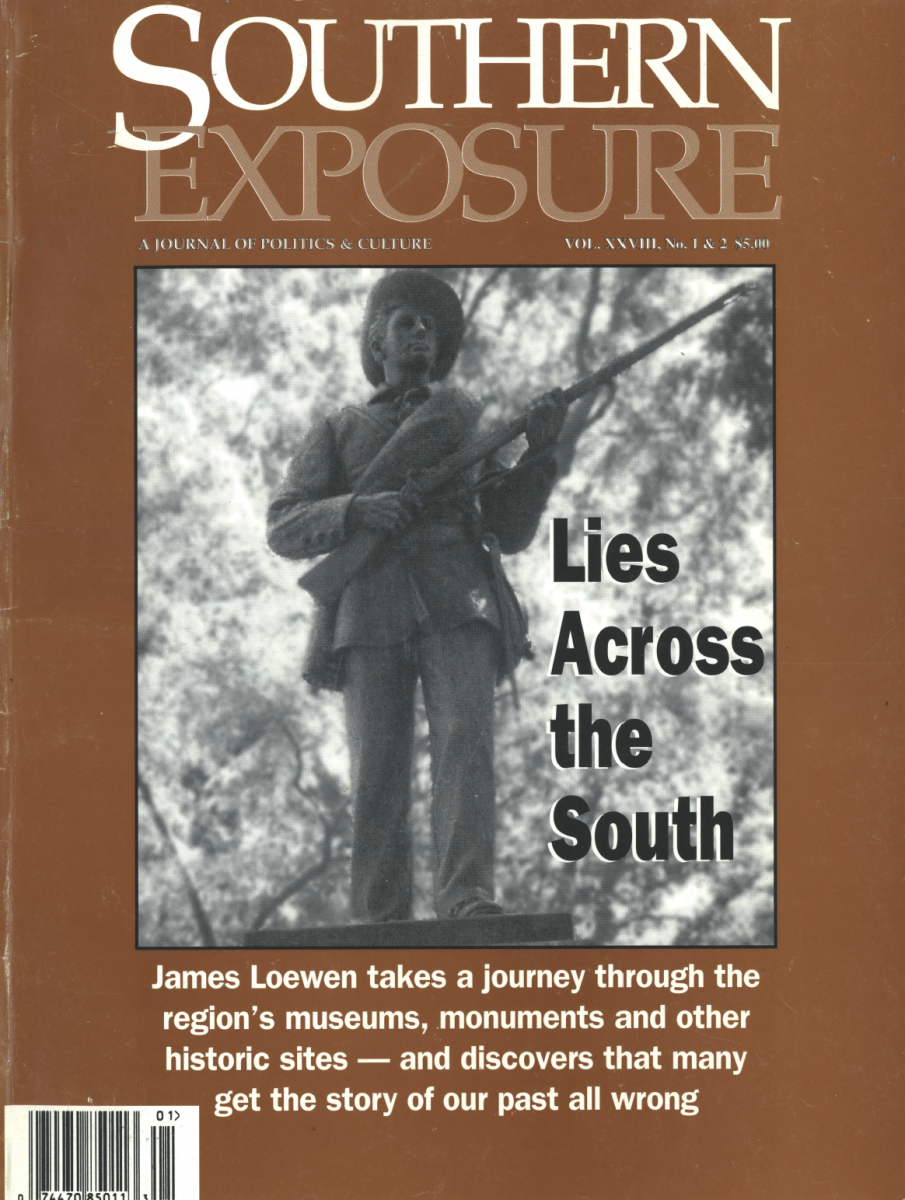
Loewen was doggedly devoted to righting misinformation about the struggle for Black freedom in the South. He's best known for his 1995 book, "Lies My Teacher Told Me: Everything Your American History Textbook Got Wrong," and wrote several others, including "Sundown Towns: A Hidden Dimension of American Racism," about communities where white people used the threat of violence to force Black people, Jews, and other oppressed groups to leave before nightfall.
Loewen was a friend to the Institute for Southern Studies, publisher of Facing South. He wrote a story called "Lies Across the South" for the spring/summer 2000 issue of Southern Exposure magazine, Facing South's print forerunner, that we're republishing here. It looked at the ways historical markers and sites across the region distorted the truths of the Confederacy, the Civil War, and Reconstruction — and it foreshadowed the debates over remembering the past that have gripped the country in recent years.
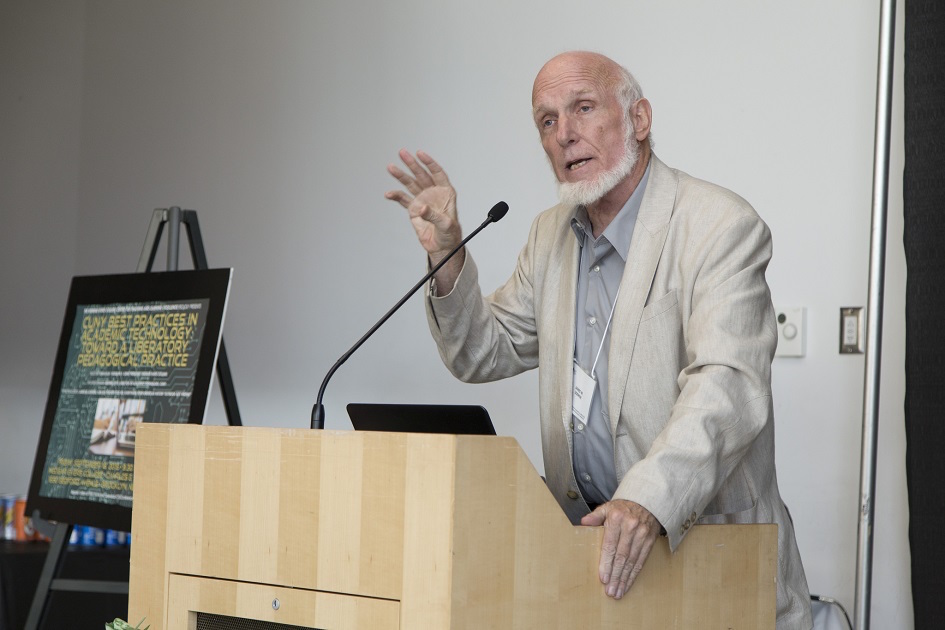
Informed by the work of Loewen and others, some historical sites discussed in the story now make an effort to more accurately represent reality. Guides at Thomas Jefferson's Monticello, for one example, make slavery so central to their tours today that they get angry pushback from resentful white tourists. In Louisiana, the historical marker for the so-called "Colfax Riot" has been removed. Most of the statues on Confederate Row in Richmond, Virginia, were taken down following the racial justice uprising sparked by last year's Minneapolis police murder of George Floyd. And just last month, Tennessee's State Building Commission voted to remove from the state capitol the bust of Confederate general and KKK leader Nathan Bedford Forrest, which was relocated to the Tennessee State Museum.
By republishing this two-decade-old look at the South's monuments and historic sites, our hope is to deepen understanding of the long movement for memorial justice in the South — and appreciation for Loewen's critical contributions to it. As he stated in the quote with which he closed his emails, "Telling the truth about the past helps cause justice in the present. Achieving justice in the present helps us tell the truth about the past."
As a region, the South is distinctively haunted by history, as observers from William Faulkner to the late C. Vann Woodward have noted. Actually, as its landscape makes plain, the South is distinctively haunted by mis-history.
All across the South, from Maryland to Texas, historical markers, monuments, and historic sites get history wrong, mostly on purpose.
Don't get me wrong: this is a national problem. But Dixie has it worse than any other region.
Some errors are fun, like the marker in Pittsburg, Texas, that tells of "The Ezekiel Airship," invented by Baptist minister Burrell Cannon. Texas claims it "was briefly airborne at this site late in 1902, a year before the Wright brothers first flew" — but it wasn't.
Some errors are harmless, such as the battle on the landscape between Brunswick, Georgia, and Brunswick County, Virginia, over where Brunswick stew was born. Recently, Brunswick County, North Carolina has also put in a claim.

Many errors are not so innocent. What do we make of the courthouse square in Scottsboro, Alabama, for instance? It boasts four historical markers but omits any mention of the event that made Scottsboro famous around the world, the case of the Scottsboro Boys. Recall that in 1931, nine black youths riding a freight train through northern Alabama were accused of raping two white women. Neither woman had been raped, it turned out, but eight boys were sentenced to death anyway, and one, just thirteen years old, to life in prison. Appeals went to the U.S. Supreme Court four times; after international protests, all nine were freed, the last in 1950. The four markers imply that Scottsboro considers it important to know about its past, but Scottsboro does not.
All too often across the South, communities that are notorious for a certain event make no mention of that event. Meanwhile, they put up historical markers and monuments that tell of incidents that are laughably insignificant in comparison. The result is a landscape of amnesia, of which Scottsboro offers only a particularly outrageous example.
Accounts of history on the landscape should begin with American Indians, but too often the landscape makes Native Americans invisible. A state historical marker in Baldwin, Louisiana, narrates the death of Hernando De Soto, who "was buried in the Mississippi River, which he discovered." Such language implies that American Indians weren't there or weren't people — which would have amused the Spanish, who buried De Soto in the river to keep the Indians from knowing he was dead. According to a Texas state historical marker near New Caney in Montgomery County, "Permanent settlement in what is now New Caney began in the 1860s," but according to The New Handbook of Texas, "the area that now comprises Montgomery County … has been continuously occupied for more than 10,000 years." This marker's language implies that Indians weren't there or only "roamed."
Markers do give fuller attention to the almost-continuous warfare between European Americans and Native Americans that marked Southern history from 1526 — when conflict with Indians caused a Spanish colony to abandon their settlement in the Carolinas — to the 1830s. The 1715 Yamasee War, for example, which took the lives of some 400 whites — 6% of the white population in the Carolinas — is recognized in a South Carolina marker about Fort Moore, built "following the disastrous Yamasee War." Few history textbooks even mention this important war, which killed far more than 400 Indians and wiped out some smaller tribes entirely.
Several Georgia state markers treat what they call the "Southern Indian Wars" of 1836 as connected with the removal of the Cherokees. The battles they commemorate, such as the "Battle of Chickasawachee Swamp" and the "Battle of Brushy Creek," have disappeared from our history textbooks. Conflict with Native Americans gets much attention in West Virginia (20.1% of 750 historical markers) and Texas. But most markers use biased terms to mischaracterize this history.
How many people does it take to make a massacre? Just two, if they're white, according to a Florida state historical marker titled, "The Bradley Massacre," about the 1856 killing of Capt. Robert Duke Bradley. Meanwhile, incidents that killed hundreds of Indians, including noncombatants, are routinely labeled "battles."
The Plantation Houses: Missing the Slaves for the Silverware
Across the South, impressive antebellum plantation houses are so commonplace that their brochures engage in a battle of superlatives to lure the tourist dollar. Westover is "the nation's premier example of Georgian architecture" while Agecroft Hall "is rich in hand-carved craftsmanship." Belle Air is a "rare architectural monument" but Shirley Plantation is "an architectural treasure." Tuckahoe is “the finest existing early 18th century plantation in America;” Carter's Grove at Colonial Williamsburg is "the most beautiful house in America" — and we haven't even left the James River valley!
Elsewhere in Virginia lie Kenmore, Belle Grove, George Mason's Gunston Hall, James Madison's Montpelier, "Thomas Jefferson's Poplar Forest," and of course Jefferson's Monticello. Granddaddy of them all is George Washington's Mount Vernon, which claims to be "America's most popular historic home." But Mount Vernon is only granddaddy in Virginia. Perhaps the most visited plantation in the United States is Andrew Jackson's Hermitage, outside Nashville.
South Carolina has its own plantation row, northwest of Charleston along the Ashley River, where visitors can choose among Drayton Hall, "the oldest and finest surviving example of Georgian Palladian architecture in the South," Middleton Place, "America's oldest landscaped gardens," and Magnolia Plantation, "this hemisphere's oldest major garden." Even more magnificent are the plantations farther west in Louisiana and around Natchez, Mississippi.
Most of these sites revel in what they call "our Southern heritage," but omit most of their history. Nine of every ten people living at The Hermitage, for example, were enslaved African Americans. The audio tour gives them just one sentence, mentioning their number (130). At the gate to Magnolia Plantation a billboard offers "The Complete Plantation Experience" — yet Magnolia tells next to nothing about the experience of most of the people who lived there.
Indeed, antebellum home sites go to extraordinary lengths to avoid mentioning slavery. Guides supply minutiae about the things — silverware, portraits, porcelain — but volunteer nothing about the people who worked there to pay for them. At Hampton Manor, a National Park site just north of Baltimore, guides avoid speaking of slaves by having things done in the passive voice: the right-hand wing "is where the laundry was done," while the left wing "was for the cooking."
Slaves built their own houses and the owners', too, grew their own corn and the owners', too, butchered the hogs, and made their own clothing — or they raised the crops for sale that paid for the corn and nails and clothing. Nevertheless, the language at most plantations today makes them invisible.
Instead of telling this story, each plantation has its multi-talented owner who seems to have done all the work himself. At the Edmonston-Alston House in Charleston, South Carolina, Charles Edmonston "built his residence"; then "Alston modified the appearance of the house …" In reality, neither Edmonston nor Alston laid hammer to nail. At Hampton, today's visitors walk through a landscape cleared by slaves, past trees planted by slaves, and tour a mansion paid for and mostly built by slaves. Yet Hampton's brochure claims, "Eliza Ridgely planted exotic evergreen and deciduous specimen trees…"
"Let me show you the builders of the house," says a guide at the Hampton House. I imagine we'll learn something about the slaves, perhaps also the free artisans, white and black, who labored here. Instead he leads us to stand beneath the portraits of Charles Ridgely, the first owner, and his wife. When workers are mentioned, guides and brochures euphemize to avoid the word "slavery." Slaves become "servants" or even "antebellum workers." Owners become "masters."
Most antebellum home sites never tell of a single African American by name. Therefore, visitors never realize the incredible drama that a life in slavery often entailed. Some plantations do latch onto one "Tonto" figure. This is a hoary rhetorical device in white culture: by recognizing "the good" in one African American — always loyal to the white side — the narrator implies that the system was fair and that "good Negroes" liked their "masters." At Magnolia, it's Adam Bennett, who saved the silverware when Union soldiers demanded it. At The Hermitage, it's "Uncle Alfred," who was born in slavery but “chose to stay on after emancipation.” At Hampton, the guide and brochure tell of Nancy Brown Davis, "born a slave in 1838. She chose to stay on as a servant after she received her freedom." All that visitors learn about the lives of Bennett or Alfred or Davis is their choice to throw in their lot on the white folks' side.
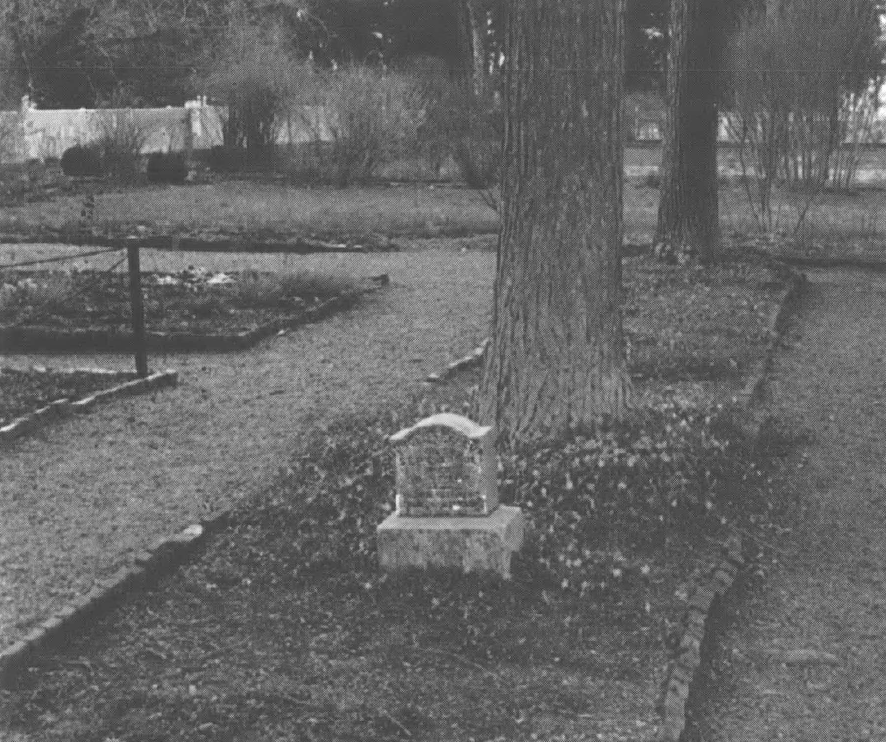
"Uncle Alfred" gets no last name, even on his tombstone, which says only: Uncle Alfred died Sept. 4, 1901. Aged 98 years. Faithful servant of Andrew Jackson. (Photo by James Loewen)
That choice, in turn, prompts guides to claim that their master was kindly. To borrow a Minnesota metaphor, historic houses follow the Lake Wobegon principle: every owner was above average! An African American who visited Mount Vernon in 1998 reported, "They give the impression that the slaves at Mount Vernon lived quite well. If you were going to be a slave, that was the place to be one." Julian Niemcewicz, a Polish poet who spent two weeks at Mount Vernon in 1798, took away quite a different impression:
We entered some Negroes' huts for their habitations cannot be called houses. They are far more miserable than the poorest of the cottages of our peasants. The husband and his wife sleep on a miserable bed, the children on the floor…
No antebellum house shows that slavery was a penal system, resting ultimately on force and threat of force. Never have I seen on display a whip, whipping post, chains, fetters, branding iron, or any of the technology of mobile human confinement that owners devised — bells that could not be removed from the neck. Only once in my experience, at Carter's Grove, has a guide mentioned that sometimes owners or overseers cut off a toe or even a foot to punish running away and prevent recurrence. Never have I heard a discussion of the appalling practice known as "seasoning," the forced resocialization imposed to break slaves' will to resist. Instead, guides and brochures present plantations nostalgically as vanished communities. They allow today's visitors to conceptualize living, working, reproducing, and dying on the old plantation as an idyllic retreat from the modern world. They never disclose that more than 90% of the people who lived there were held against their will.
Most plantations sites happily display only the owner's lifestyle. Every house boasts a dining table with elaborate place settings. None mentions that "the slaves had to eat with mussel shells for spoons, and we sopped our gravy with our bread," as an ex-slave told a Mississippi researcher in the 1930s.
Plantation guides could intrigue young visitors by telling of the contrast in table manners between young slaves and their owners' children. On some plantations, planters had slave children eat from troughs, with or without wooden paddles or spoons. As one ex-slave remembered 70 years later,
There was a trough out in the yard where they poured in mush and milk, and us children and the dogs would all crowd 'round it and eat together. We children had homemade wooden paddles to eat with, and we sure had to be in a hurry about it, because the dogs would get it all if we didn't.
Such details might lead visitors to imagine the response of white owners and their elegant guests, witnessing slave children tussling over their morning or evening meal. In the nineteenth century, the scene "proved" that slavery was right: "They eat like animals!"
Dauphin Island, Alabama & Augusta, Georgia: Celebrates the Raiders & Patrollers
The landscape omits two topics almost completely: the slave trade, including the international trade, and the patrol system. Every American knows of the era of lawlessness called Prohibition, 1919-1933, when for 14 years law enforcement officials in many parts of the country turned a blind eye to the illegal liquor trade. But almost no one knows that for 53 years, from 1808 to 1861, law enforcement officials in much of the country turned a blind eye to the illegal slave trade. As with Prohibition or the drug trade today, making slave importation illegal, coupled with erratic enforcement, ensured that it would be profitable by increasing the price differential of slaves in the United States compared to West Africa. The inability of the federal government to enforce its own laws demonstrated the pervasive influence of what abolitionists called "the slave power." Even our foreign policy and armed forces were corrupted by the trade. Nothing the Mob could muster during Prohibition came close.
Americans learn in school that "slaves were imported until 1808 when the United States Constitution banned the slave trade," in the words of one textbook. Actually, the Constitution never banned the slave trade; on the contrary, Article 1 Section 9 guaranteed that it "shall not be prohibited by the Congress prior to the year 1808." In 1807, Congress passed an act prohibiting the African slave trade, to take effect in 1808, but according to historian John R. Spears, the law "was a mere dead-letter," because the United States did not enforce it. In December, 1810, President James Madison wrote Congress, "American citizens are instrumental in carrying on a traffic in enslaved Africans, equally in violation of the laws of humanity, and in defiance of those of their own country."
In the 1850s, the illegal trade from Africa grew. In 1859 Stephen A. Douglas claimed to have seen 300 Africans in one slave pen in Memphis. After the Civil War Nathan Bedford Forrest told a reporter for the Louisville Courier-Journal that he and his associates had themselves "brought over 400 slaves from Africa." As the 1850s drew to a close, many Southerners, including J.H. Adams, Governor of South Carolina, Alexander Stephens, future Vice-President of the Confederacy, and the entire Southern Commercial Convention asked Congress to reopen the traffic. Texas, Mississippi, and South Carolina developed "legal" subterfuges, such as calling Africans "voluntary laborers," that allowed the illegal trade to continue more and more openly. At least in the Deep South and Texas, slave captains hardly feared conviction by juries of their peers. To the eve of the Civil War, slavers were constructing new slave ships, including Clotilde*, built in 1858.
Clotilde entered Mobile Bay in July, 1860. Some Africans apparently escaped at that point; others were sold to Alabama plantation owners. After the Civil War many of these people reunited in a section of present-day Mobile and Prichard still known as "Africa Town." The last survivor of Clotilde, Cudjo Lewis, died in 1935, having lived more than a century. In front of the Union Baptist Church that he helped found is a bust of him with the simple inscription, "1859."
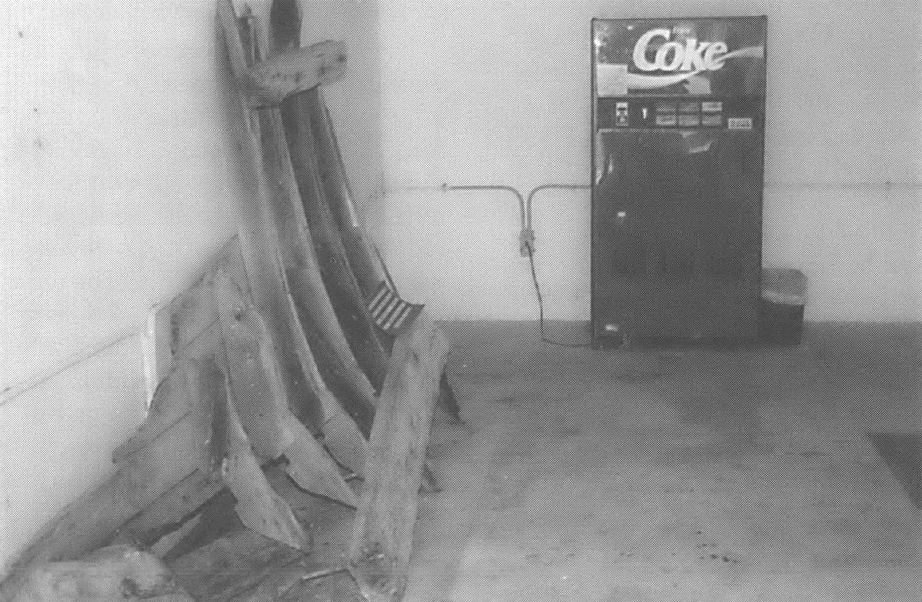
On Dauphin Island, Alabama, guarding the western entrance to Mobile Bay, stands Fort Gaines. The fort played an important role in the Battle of Mobile Bay in August of 1864, well-told by its self-guided walking tour. Tucked away next to the Coke machine in a side room is a little display that most visitors miss. Some timbers from the slave ship Clotilde provide almost the only physical evidence on the American landscape that acknowledges that the illegal international slave trade continued. A small label tells the story but provides no date: "These are the remains of the lat slave ship to deliver its cargo to a United States port. The ship was named Clotilde. After it entered Mobile Bay it wass run aground and its cargo was unloaded. The ship was then burned to the waterline." (Photo by James Loewen)
In fact, Clotilde was not the last slave ship to deliver slaves successfully to the United States. According to Daniel Mannix, historian of the slave trade, the last slaves brought to the United States from Africa landed near Smyrna, Florida, in the spring of 1861, shortly before Confederate shelling of Fort Sumter ignited the Civil War. On April 21 of that year, after the war began, an American slave ship was intercepted just north of Angola with 961 Africans on board; 160 died before they could be put ashore in Liberia. 270 Africans, possibly from Cuba, landed at a plantation on the Savannah River even later, on December 16, 1861. It took the Civil War to end the slave trade for good.
On U.S. 278 near Augusta, Georgia is the only historical marker in the United States, as far as I know, that treats the notorious “patroller” system that controlled slaves when they left their owners' plantations. Its text is so cryptic, however, that no passerby would guess its topic. The marker says:
Beech Island Agricultural Club
On January 5, 1856, Governor James H. Hammond and eleven other farmers of this area organized the Beech Island Agricultural Club for the diffusion of agricultural knowledge and the regulation of illegal slave traffic. Monthly meetings and barbecues have been held almost without interruption since the club's founding.
The first thing the marker gets wrong is the full name of the "club," which was the Beech Island Agricultural and Police Society. The society did share ideas about agriculture — fertilizers, new crops, and the like — but its primary purpose, however, was to keep slaves in line. "The regulation of illegal slave traffic" does not refer to the international slave trade. Slaveowners wanted to stop slaves who were moving about, going to town, and even making money by taking goods from the plantation and selling them.
The founding document of the Beech Island Agricultural and Police Society makes clear that its purpose was to control slaves:
We, whose names are herewith subscribed, do hereby join, to form ourselves into a Society, for the purpose of communicating our opinions on subjects immediately connected with our best interests, and of acting in concert with each other, and with the fine and determined object of assisting the regular constituted authorities, in enforcing the laws relative to the government of colored persons.
Like prison inmates, enslaved persons were under the control of others, and as with convicts, that control ultimately was physical and potentially violent. A large plantation might have only five or ten whites, including young children and an overseer or two, to control a hundred slaves. Because planters always feared slave revolts, they formed police societies for mutual support. Indeed, South Carolina required whites to organize patrol systems in all jurisdictions where blacks were a majority.
In the Beech Island area in 1856, more than 60% of all people were enslaved. Patrollers — volunteers and paid — stopped all African Americans to ask their business and see their passes. Even a wife visiting her husband, enslaved on the next plantation, had to have a written pass to see him. Writing after the Civil War, a white South Carolinian told of hearing acquaintances brag "with great gusto how in the good old times they used to hunt down runaway Negroes with hounds and guns, brand them, beat them til senseless, and while patrolling at night flog Negroes who had passes 'just to hear them beg.'" Throughout the South, even slaves on errands for their owners with legitimate passes feared patrollers.
Historian Richard Zuczek tells that South Carolina planters briefly reinstated the patrol system in 1865, even though the Civil War had supposedly ended slavery. During Reconstruction, the night-riding of the Ku Klux Klan and Red Shirts was a further extension of patrolling, Zuczek notes, involving some of the same men. A marker about the Beech Island Agricultural and Police Society that accurately portrayed their relations to their laborers would convey important information about how the antebellum South worked.
Slavery was central to the world history of the past 400 years, according to historian David Brion Davis. Yet even antebellum plantations, where slavery most prominently took place, treat it as a minor aberration, an atavism the nation was somehow outgrowing. Telling the truth about slavery is not so hard. A few places do better than the rest, including Carter's Grove in Virginia, Kingsley in Florida, Somerset Place in North Carolina, and Sotterley in Maryland, which I have visited, and perhaps Dickinson in Delaware, Levi Jourdan in Texas, and Tezuco, Laura, and Oakley in Louisiana, which I have not.
Other plantations tell some truths about slavery but tuck them away, so most visitors never see them. Monticello offers a 45-minute "plantation tour" down a path in front of the mansion, during which the guide pauses to discuss such topics as the nail factory, where enslaved boys made thousands of nails a day, and the garden, with its high fence to deter theft.
During the past five years I have watched this tour become more honest; my last guide began by specifically denying that Jefferson was a particularly kind or above average "master." The plantation tour operates only from April through October, however, and fewer than one visitor in 15 takes it, perhaps because Monticello labels it "African American history." The Hermitage has a small, hard-to-read display on slavery crammed into a corner. Its archaeology program has developed important information about the lives of enslaved workers, but it has not succeeded in getting this information into the tours that most visitors take.
Jacksonville, Alabama & Alexandria, Virginia: Celebrating the Wicked
Whites who owned slaves are still esteemed for it, just as they were before 1861, and not only at antebellum homes. Consider the names on the Southern landscape. A historical marker in Jacksonville, Alabama, tells of the re-naming of Benton County, which "originally was named for Col. T. H. Benton, Creek War officer, later U.S. Senator from Missouri. Renamed in 1858 for John C. Calhoun, champion of South in U.S. Senate. Benton's views by then unpopular in South." This marker accurately describes a renaming that needs now to be undone.
The careers of John C. Calhoun and Thomas Hart Benton show several parallels. Both were wealthy slaveowners. Both were important United States Senators. Both were national leaders of the Democratic Party, and both were considered for the presidency — Calhoun served as Vice President under Andrew Jackson. Gradually, however, Calhoun and Benton diverged in political philosophy until they became arch-enemies. Calhoun took ever more extreme positions favoring the South as a region and slavery as a cause. Benton, senator from Missouri from 1820 through 1850, came to believe that slavery was wrong and should not be allowed to expand.
Benton and Calhoun both opposed the Compromise of 1850, but from opposite perspectives. Benton denied that the Constitution protected slavery and urged Congress to admit California to statehood without bargaining with radical slaveholders like Calhoun. A dying Calhoun threatened disunion one last time, claiming that the compromise didn't go far enough in guaranteeing slavery forever. It is doubtful that any compromise would have satisfied Calhoun at this point in his life. In 1858 pro-slavery extremists renamed Benton County for Calhoun precisely because Benton stood for the United States, while Calhoun did not.
Every year that Calhoun County remains Calhoun County, it declares on the landscape that John C. Calhoun was a hero worthy of the honor of having a county named for him. This statement insults every black resident of the county and every white who does not believe that treason on behalf of slavery made moral or political sense then or now.
The ideology of the Alabamians who renamed Benton County for Calhoun led to the Civil War three years later. Today the landscape misrepresents that war from start to finish. One of the first casualties in the East was Colonel Elmer Ellsworth, killed at an inn in Alexandria, Virginia, as United States forces took that town. Today the site is still an inn, the Holiday Inn in Old Town, and on its side a bronze plaque put up by the Sons and Daughters of Confederate Soldiers tells this story:
The Marshall House stood upon this site, and within the building on the early morning of May 24, 1861, James W. Jackson was killed by Federal soldiers while defending his property and personal rights, as stated in the verdict of the coroner's jury. He was the first martyr to the cause of Southern independence. The justice of history does not permit his name to be forgotten. Not in the excitement of battle, but coolly, and for great principle, he laid down his life, an example to all, in defence of his home and the sacred soil of his native state Virginia.
The plaque completely omits Ellsworth, killed at this site moments before Jackson, one of the first "martyrs to the cause" of the United States in the Civil War.
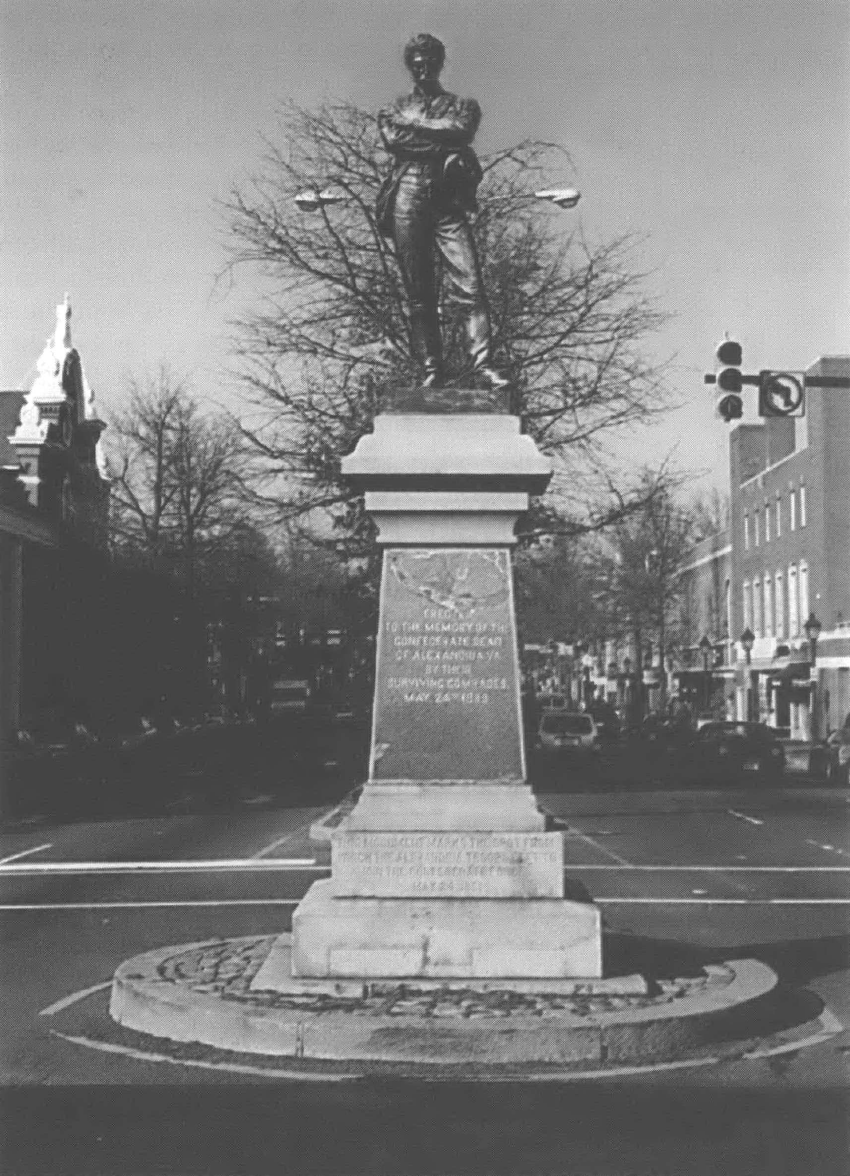
Alexandria's pensive 1889 Confederate Memorial. On its base, neo-Confederates in 1900 added "James W. Jackson" to the 99 names of Confederates from Alexandria killed in battle. Unlike all other names on the monument, he gets no unit, and the addition still looks raw and new, as if done yesterday. (Photo by James Loewen)
After the fall of Fort Sumter, Union commanders knew they could not defend Washington without controlling the land across the Potomac. In late May they decided to take Alexandria. This was the first United States offensive against the Confederacy, so it "at once attracted the attention of the whole nation," according to Julius C. Burrows, who gave the oration at the dedication of the monument to Colonel Ellsworth at Mechanicville, New York, in 1875. Ellsworth had become famous even before this incident. In 1859, his "U.S. Zouave Cadets" won the national drill championship; Ellsworth led them on a triumphant 20-city tour throughout the North.
Just after dawn on May 24, Ellsworth's regiment landed at the Alexandria waterfront. Over Jackson's inn waved a rebel flag, so large it was said to be visible from the White House. "That flag must come down," Ellsworth cried, as he entered the inn, climbed the stairway to the roof, and seized it. Descending the stairs, he was met by Jackson, who shot him through the heart. Immediately one of Ellsworth's men killed innkeeper Jackson.
Ellsworth had worked in Abraham Lincoln's Illinois law office. He accompanied the president-elect east, was in charge of his security, and lived for a while at the White House. Lincoln wept openly at the news of his death and ordered his body brought back to the White House for a military funeral. The incident may seem trivial today, but at the time it attracted the attention of the nation. Ellsworth's bloody shirt went on tour as a relic to rally money and troops for the Union and was used to recruit a new regiment named the Ellsworth Avengers. "Remember Ellsworth!" cried Union troops in early Civil War battles. On site, however, the Sons and Daughters of Confederate Soldiers have not only forgotten Ellsworth but have defamed him and converted his killer into a martyr.
Woodbury, Tennessee & Richmond, Virginia: The Myth of the Always-Victorious Confederate
Southern historical markers that tell of the next four years emphasize every Confederate victory and minimize every Confederate defeat — mystifying the outcome. In Woodbury, Tennessee, for example, Nathan Bedford Forrest gets a historical marker titled "Forrest Rested Here, July 12, 1862." It tells how his brigade “"halted for a short rest before making his successful raid on Federal forces at Murfreesboro." Meanwhile, no marker tells how, a month later, Forrest attacked a federal stockade at Short Mountain Crossroads, outnumbering them nine to one, but was defeated. Liston Pope, who grew up reading the South's historical markers, summed up the result: "I never could understand how our Confederate troops could have won every battle in the War so decisively and then have lost the war itself!"
When the tourist goes to the places that tell how United States forces took Richmond — Petersburg's Siege Museum and the National Park Service museum at Richmond — funereal music announces the "fall" of those cities.
This is bad history. When the U.S. army entered Richmond on April 3, 1865, poor whites, free blacks, Southern civilians imprisoned by the Confederacy, and Union POW's joined slaves in the celebration. A retreating Confederate, Clement Sulivane, wrote that he "heard the very welkin [vault of heaven] ring with cheers as the United States forces reached Capitol Square." A soldier with the 11th Connecticut wrote, "Our reception was grander and more exultant than even a Roman emperor, leading back his victorious legions with the spoils of conquest, could ever know." Today the cheers are silenced because the point of view is Confederate.
In Virginia, the end came at Appomattox cemetery, where the United Daughters of the Confederacy put up a marker that says:
Here on Sunday April 9, 1865 after four years of heroic struggle in defense of principles believed fundamental to the existence of our government Lee surrendered 9,000 men, the remnant of an army still unconquered in spirit, to 118,000 men under Grant.
The marker gets the date right, and the Confederacy did put up "four years of heroic struggle." Otherwise, like most markers and monuments put up by the Daughters, it cannot be relied upon.
Consider "defense of principles believed fundamental." Three weeks before the Confederacy attacked Sumter, Confederate Vice President Alexander Stephens said what these were: "Our new government's foundations are laid, its cornerstone rests, upon the great truth that the Negro is not equal to the white man, that slavery — subordination to the superior race — is his natural and normal condition." UDC leaders doubtless hoped that if they left those principles vague, readers might infer something nobler.
Were Lee's troops "unconquered in spirit?" Much contemporary scholarship emphasizes that the Confederacy eventually fell because of a failure of spirit. In the months just before Appomattox, thousands of desertions sucked the life from Lee's army and Confederate armies everywhere.
A month before Appomattox, Confederate soldier Harry Hammond wrote from Petersburg, "We have had some 60 or 70 desertions recently from the Brigade, most of them going over to the enemy at night while on picket." These men did not desert for lack of food, for Hammond went on to note, "Our supplies continue sufficient." Carleton Beals notes that the Confederate army was breaking up by the spring of 1865 in Texas and other states, even without Union approaches. He concludes that its ideological contradictions were the Confederacy's gravest liabilities, ultimately causing its defeat. White Southerners were fighting to preserve slavery partly because they believed it was good for blacks, or at least maintained they did. Yet during the war African Americans behaved in ways that expressed their clear dissatisfaction with slavery. The success of black United States troops led to proposals by Confederate leaders to arm slaves, which threw Confederate ideology into further confusion.
The UDC gets even the numbers wrong. When Lee surrendered, he asked that some sort of parole slip be given to his men so they would face no problems going through Union lines. Grant agreed, and during the next five days a small printing press churned out more than 28,000 slips given to soldiers in Lee's surrendered army. Between 3,000 and 3,500 men who lived nearby just went home without waiting for their slips. To say "Lee surrendered 9,000 men" is preposterous. Similarly, Grant did have about 120,000 men in his final Petersburg-Appomattox campaign, but only about 63,000 were at Appomattox Court House. United States forces did outnumber Confederate States forces by almost two to one throughout Lee's flight from Petersburg to Appomattox, but that wasn't good enough for the United Daughters of the Confederacy. Of course, if Union soldiers outnumbered Confederates 13 to 1, as the Daughters would have it, one need look no further to learn why the Confederacy lost the war. So that's the motive for getting the numbers wrong.
Mississippi & Todd, Kentucky: The Phantom Confederates
Although many Confederates were conquered in spirit in 1865, between about 1890 and 1930, neo-Confederates declared victory on the landscape all across the United States, including places that never existed or never were Confederate during the war. A Confederate monument dominates the lawn of the east Bolivar County courthouse in Cleveland, Mississippi, for example, "To the memory of our Confederate dead, 1861-65." The only problem is, Cleveland, Mississippi had no Confederate dead. Cleveland did not exist during the Civil War or for some decades afterwards. According to the History of Bolivar County, "until 1900 most of the interior of Bolivar County was a vast forest." The area around Cleveland "was a wild country, abounding in bear, deer, wild turkey, and wolves."
Across the state, the Confederate monument in Ellisville, Mississippi exemplifies a different distortion of history. In 1912 the UDC erected an imposing monument in front of the courthouse for the southern district of Jones County. During the war, however, most residents of Jones County opposed the Confederacy. Newt Knight, a white farmer with a black wife, even led a revolt that briefly took over the Ellisville courthouse. He declared the county "The Free State of Jones"; Confederate officers had to dispatch troops to force the county back into line. But today, the courthouse is securely under Confederate control.
The border [states] are held sway under neo-Confederates as well. Kentucky, for example, did not secede. Early in the war, Confederate General Albert Sidney Johnston occupied Bowling Green, 40 miles east of Todd County, but he found "no enthusiasm as we imagined and hoped but hostility was manifested in Kentucky." Eventually, 90,000 Kentuckians would fight for the United States against 35,000 for the Confederate States. Nevertheless, according to historian Thomas Clark, the state now has 72 Confederate monuments and only two Union ones.
In Confederates in the Attic, Tony Horwitz records the impact of one of these monuments, in Todd County. "Todd County wasn't rebel country, at least not historically," he points out. "Most Todd Countians supported the Union in the Civil War." But this history has been lost. "Almost all whites I spoke to … proclaim[ed] their county rebel territory and believ[ed] it had always been so. As proof, they pointed to a 351-foot concrete spike soaring at the county's western edge. The obelisk marked the birth site of Confederate president Jefferson Davis." The United Daughters of the Confederacy dedicated it in 1924 and consider it "the greatest of all monuments built to the Confederate cause."
The state puts out an astonishing brochure, "Jefferson Davis State Historic Site," that is an unabashed apologia for Davis. Every year on Davis's birthday, Todd Countians converge at it for what Horwitz calls "a bizarre rite: the crowning of a local teenager as 'Miss Confederacy.'" UDC and SCV members judge contestants on their "poise, hair, hooped skirt, and answers to questions such as, 'What will you do while holding this title to promote and defend Southern heritage?'"
Thanks to this monument, whites in Todd County invented a past in which their land was staunch rebel territory and their ancestors brave Confederates. Like many schools, their high school named its sports teams "the Rebels" and took as its mascot two cartoonish Confederates waving the Battle Flag of the Army of Northern Virginia.
One result is racial polarization. On January 14, 1995, four young African Americans pursued a pickup flying a large rebel flag from a pole in its truck bed. An occupant of the truck may have shouted "nigger" at them. Shooting blindly into the cab, 17-year-old Freddie Morrow killed its owner, 19-year-old Michael Westerman. Since the shooting, the races have grown still more polarized. The Southern Partisan, official magazine of the right-wing League of the South, calls Westerman a "Southern Patriot and Martyr." The Ku Klux Klan has marched and recruited in the county. Families of the victim and defendants have expressed sorrow and called for reconciliation. But an outpouring of white opposition prevented school officials from changing the high school's Confederate symbols.
Gainesville, Texas: "White and Fair," but so Free of Crime?
One reason why many white Southerners (and some Northerners) identify with Confederate symbols today is to declare themselves rebels against central authority. Neo-Confederates imagine that Southerners were rebelling against an authoritarian national regime. They do not know that the Confederacy brooked far less dissent, in part because of the lies on the landscape. On the Cooke County courthouse lawn in Gainesville, Texas, for example, stands an impressive Confederate monument with this inscription:
God holds the scales of Justice;
He will measure praise and blame;
And the South will stand the verdict,
And will stand it without shame.
Oh, home of tears, but let her bear
This blazoned to the end of time;
No nation rose so white and fair,
None fell so free of crime.
All across America, Confederate memorials insist that their cause was without blemish. This verse in Gainesville is particularly troubling, since something grim happened on these very grounds.
During the early morning hours of October 1, 1862, Confederate militia scattered through Cooke County and neighboring counties, seizing Texans suspected of favoring the United States. In all, they arrested more than 200 people. By noon, they had locked 70 of them in a vacant store on the courthouse square in Gainesville. In the words of Richard McCaslin, whose fine book, Tainted Breeze: The Great Hanging at Gainesville, Texas, is the standard history of the event, "Vigilantes executed at least 42 of these prisoners for conspiring to commit treason and foment insurrection." It was the largest mass hanging in American history. According to McCaslin, "Few of the victims had plotted to usurp Confederate authority, and most were innocent of the abolitionist sentiments of which they were accused."
Nor were the 42 hangings the extent of the violence. Confederates hanged five more men in Wise County on October 18 and still others in nearby Grayson and Denton counties. Historian Richard Brown believes as many as 171 people may have been killed in all.
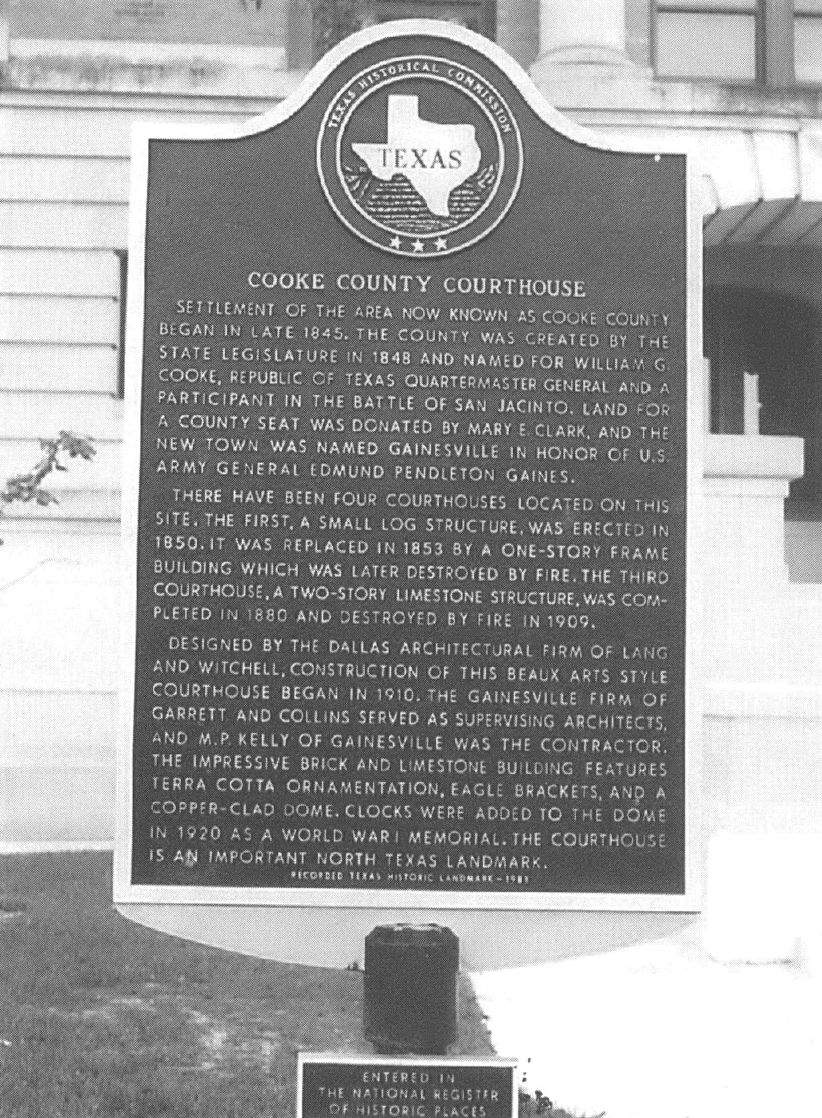
When this monument went up in 1911, Gainesville already had a Confederate Soldiers7 monument in Leonard Park, erected just three years earlier. This second monument at the courthouse amounts to a continuing counterfactual coverup. (Photo by James Loewen)
These North Texas events were hardly unique. Other mass killings of dissenters happened elsewhere in Texas and in Kansas, Tennessee, North Carolina, and other states. None of the perpetrators was ever charged with crimes by the Confederacy; several were promoted. In contrast, historian Mark Grimsley points out that the United States took a softer course and "applied the insurrectionary principle sparingly. Had it done so broadly and consistently, captured Confederate soldiers and civilians who gave aid and comfort to the Confederate regime might well have faced execution."
The United States did expel some dissenters to Canada and to the Confederacy and locked up others without trial for a time. On the whole, however, historian James McPherson summarizes the Lincoln administration's policy toward Confederate sympathizers and saboteurs as "remarkably lenient, under the circumstances. No Northern civilians were executed for such activities."
Many north Texans had opposed secession, including 61% of Cooke County voters in the secession referendum of February 1861. After the war, however, continuing neo-Confederate vigilante violence finally achieved in north Texas what secessionists could never accomplish before or during the contest: now a majority supported the Lost Cause. The erection of the Confederate monument shows that neo-Confederates controlled the courthouse in 1911, and in 1998 white Gainesville was still gathering there to celebrate its Confederate heritage. Speakers including the Mayor of Gainesville, Cooke County Judge, State Representative, a nearby professor of history and commanders of the Sons of Confederate Veterans "profess[ed] reverence for Southern history by those who wrote it in sacrificial blood," praised those who supported "a heritage of freedom and democracy," and recognized "those who fought and died for a just cause." The Gainesville Daily Register gave the event front page coverage on March 10, 1998. The monument had worked its spell: not one speaker mentioned the Confederate history that really happened in Gainesville.
Colfax, Louisiana: The Murder of Reconstruction
During Reconstruction, 1866 to 1876, "America tried democracy," as writer Lerone Bennett put it: "All over the South, in those years, Negroes and whites shared streetcars, restaurants, hotels, honors, dreams." Indeed, Bennett believes "the right reading of [Reconstruction] might still mark a turning point in our history." But the Southern landscape conspires to make sure that we don't get that reading. It makes Reconstruction almost invisible. Reconstruction governors of Southern states get no statues; few even get historical markers. Instead, monuments, markers, and historic sites across the South celebrate the white racist Democrats who during the 1880s and 1890s reversed the democratic policies that interracial Republican administrations enacted during Reconstruction.
In Colfax, Louisiana, is one of the few historical markers that treats Reconstruction. Its text can most charitably be described as outrageous:
Colfax Riot
On this site occurred the Colfax Riot in which three white men and 150 Negroes were slain. This event on April 13, 1873, marked the end of carpetbag misrule in the South.
Calling the Republican government of Louisiana "misrule" is ludicrous, compared to the horrifying violence perpetrated by Democrats to end Republican control and to the racist policies and fiscal scandals of subsequent Democrat officeholders. The old tag "carpetbag" implies that Republicans who came to Louisiana from the North were paupers carrying all their belongings in carpetbags, intending to plunder the state. The term is an affront to the whites and blacks, school teachers and government workers who came to Louisiana during Reconstruction to make it better. For that matter, the Colfax Riot did not mark the end of Reconstruction in the South. Republican administrations continued in Florida, Mississippi, North Carolina, South Carolina, and even Louisiana for two to three more years. The riot might be considered the beginning of the end of Reconstruction, however. At any rate, it shows how the end would come.
The Colfax massacre was "the bloodiest single act of carnage in all of Reconstruction," in the words of Eric Foner, a distinguished scholar of the era. That is saying a lot, because violence was emblematic of the period. In Louisiana in the summer and fall of 1868, white Democrats killed 1,081 persons, mostly African Americans and white Republicans. Across the Mississippi state line, whites killed an average of one African American a day in Hinds County alone, especially targeting servicemen. White Democrats mounted similar violent attacks from Virginia to Texas. The Colfax massacre was also a turning point because it showed the unwillingness of the United States to enforce Reconstruction laws, including the 14th and 15th amendments.
The United States did eventually indict 97 alleged perpetrators, charging a conspiracy to deprive the victims of their civil rights, but only got three convictions. Then the Supreme Court overturned even those three, holding that the 14th and 15th Amendments only prohibited violations of black rights by states, not by individuals or organizations. Thus it gave a green light to private terrorism. Colfax accordingly became not only the spark but also the blueprint for the overthrow of interracial Republican rule in the South. Reconstruction was destroyed not because white and black Republicans were failing to establish viable governments and an interracial society, but because they were succeeding. That is the truth about Reconstruction, a truth that the Colfax Riot marker takes pains to obscure.
Antebellum homes might tell about Reconstruction, since they all existed through the period, but they freeze themselves in a historic moment some time before freedom came. What happened next? Did their enslaved labor force escape to the nearest Union-held lines? Did any fight for freedom in the United States Army or Navy? Historians write that the behavior of "their blacks" during and immediately after the Civil War was a moment of truth to owners — a truth that antebellum homes hide from today's tourists. What happened politically after the war? Did African Americans on this plantation vote for the interracial Republican coalitions that controlled most Southern states? Descendants of slaves still live near most plantations, but few sites have tried to involve them in telling this story. What did the former owners do? Were they white supremacist Democrats? Did Ku Klux Klan activity play a role in returning Democrats to power?
The staffs at most plantations are silent about Reconstruction, offering not a word nor showing a single object that might tell what took place there then. "After the Civil War, the plantation became unprofitable" is all most antebellum sites say about Reconstruction. Visitors who do the math will discern that their vast antebellum profits, on display in their huge mansions and gardens, were indeed wrung "from the sweat of other men's faces," to quote Lincoln's "Second Inaugural." As soon as their workers had to be paid, plantations were no longer cash cows.
Southern Arkansas: Today's Politics Shape Yesterday's History and Vice Versa
What difference does all this make today? Markers and monuments don't cause history, of course. It's more the other way around: dominant groups use their power to force historic sites to present history from their viewpoint. In turn, controlling what people say and think about the past is an important source of social power. Perhaps George Orwell would not mind this rephrasing of his famous couplet from 1984: "Who controls the present controls the landscape. Who controls the landscape controls the future."
Three counties below Little Rock show these connections between the social structure of an area, its ideology, and the story its monuments tell. Camden, the county seat of Ouachita County, looks like a traditional plantation town, complete with columned mansions. Its courthouse sports a traditional monument, "To Our Confederate Women," dedicated in 1914, that joined a Confederate monument put up in 1886 in the Confederate Section of Oakland Cemetery, that replaced an even earlier obelisk.
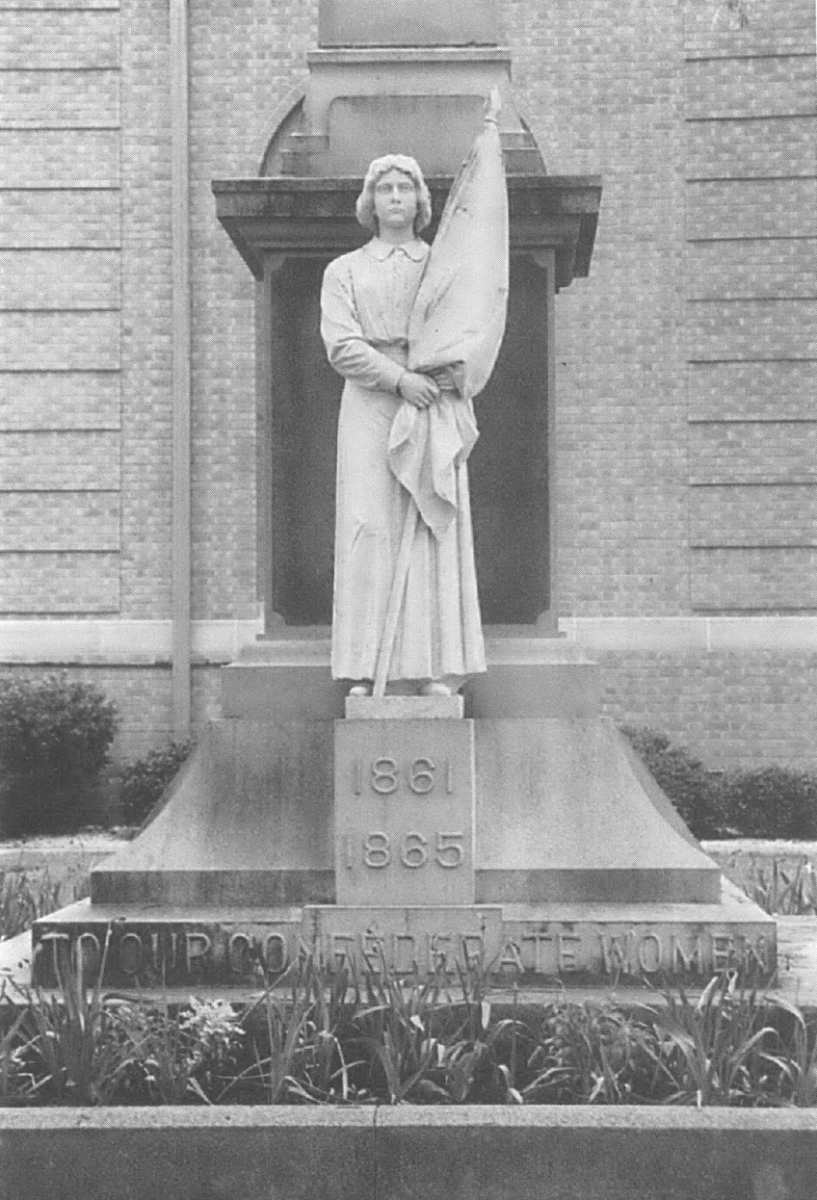
By 1914, most wives, widows, and mothers of Confederate soldiers were no longer alive; clearly the Ouachita County memorial was not intended for them. Instead, like most monuments to the Confederacy, Camden's is future-oriented. In its words, whites erected it so the "patriotism" of these women "will teach their children to emulate the deeds of their sires." In 1914, the "Lost Cause" was no longer lost: regarding race relations, although not secession, Confederate ideology was securely in the saddle. The monument implies this triumph: "Their inspiration transformed the gloom of defeat into the hope of the future." (Photo by James Loewen)
Neo-Confederates never took over the landscape in Dallas County, the next county north. The courthouse in Fordyce has no statue, and the town looks less traditionally Southern. Dallas County looks neutral — neither Confederate nor Unionist. The next county North is Grant, named for one Union general; its county seat, Sheridan, is named for another. The Grant County Courthouse grounds have a marker for the "Blue Star Memorial Highway" (a tribute to the Armed Forces of the United States) and a memorial for soldiers in the two World Wars — both lacking in Ouachita — and nothing for the Confederacy.
Different social structures in the three counties led to different ideologies, visible today in the names and monuments on the landscape. Before the Civil War, Ouachita County was good land for cotton farming, drawing planters with their slaves from Alabama. The land in Grant County was never conducive to large-scale plantations; its inhabitants were mostly white small farmers. Dallas County was intermediate, with some slaves and some independent white farmers.
The ideological clues on the landscape point to and reinforce these differences in society that persist even today. In 1990, only 62% of the black residents of Ouachita County owned their homes, compared to 74% in Dallas County and 88.5% in Grant County. African Americans made just 49% as much as whites in per capita income in Ouachita and 48% in Dallas, but 76.4% in Grant County. These numbers confirm what the landscape implies: Grant County is the most hospitable of the three for African Americans.
Today, few people in the three counties make their living from the land, so the presence or absence of plantation social structure no longer explains the racial disparities directly. Plantations left an ideological legacy, however visible on the landscape. When Confederates are heroes, as they are on the streets of Camden, then to argue for social or economic equality can seem a bit outlandish. Thus "Which came first, the statue or the oppression?" is more complicated than it seems. The oppression came first, clearly, for without slavery no Confederate cause would have arisen, hence no memorials. But the monuments and names on the landscape symbolize and help maintain (in Ouachita) or decrease (in Grant) the racial disparities that still exist. Changing the landscape is therefore one step toward relieving the oppression.
Historical Landscaping: Reclaiming Our Past
Some changes for the better have been made on the landscape. Professional staffs in state marker offices from Texas to Virginia are rewording some of the offensive old markers that mistold Indian history. Virginia changed “Last Indian Outrage,” for instance, to “Last Indian-Settler Conflict,” a much more accurate title. Since 1989, Tennessee has erected more than 100 markers that treat African American history, including a hard-hitting description of Ida B. Wells's crusade against lynchings in Memphis. In Alabama, accurate markers tell of the work of Martin Luther King Jr. in Montgomery and the Selma to Montgomery march in Selma. Birmingham and Memphis boast impressive civil rights museums.
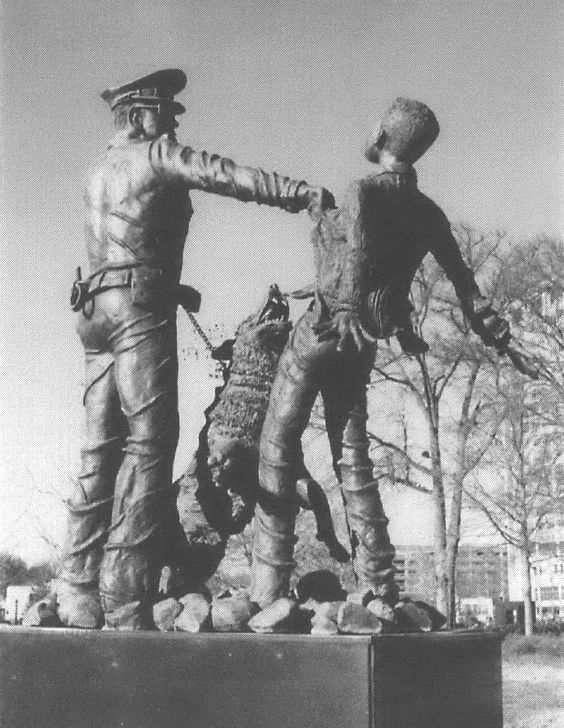
In Greensboro, North Carolina, a marker tells of the first sit-ins, even though the Woolworth store itself has gone out of existence. North Carolina has also included women in its history, both on historical markers and at its new state historical museum in Raleigh.
Sometimes new markers result from the efforts of one person or organization. Marcus Phillips was the driving force behind a recent West Virginia marker that tells how Union Carbide disregarded workers' health while drilling the Hawks Nest Tunnel, resulting in the worst occupational disaster in U.S. history. Phillips's father was one of 764 men who died from silicosis contracted in the tunnel.
Perhaps most heartening of all, citizen groups in several places have come together to put up new historical markers and monuments that tell of events previously banished from the landscape and even from memory. In Wilmington, North Carolina, in 1998, community leaders came together to recall the race riot of a century earlier that ended interracial rule in Wilmington and the state. Included in the remembrance was a play, seminar, and an accurate historical marker about the expulsion of Alex Manly, black publisher, and the destruction of his newspaper. In Georgia last summer an interracial group erected a state historical marker that noted the "Moore's Ford Lynching," in which a white mob killed two black couples in 1946.
All across the South, and indeed the nation, streets have been renamed and monuments erected to honor Martin Luther King. This approach results in a landscape memorializing white racists and black antiracists. The University of Texas, for instance, features statues of Jefferson Davis, Robert E. Lee, Albert Sidney Johnston, and a fountain claiming the whole thing was about states' rights. Last fall the university dedicated a new statue of Martin Luther King Jr. The most famous example of this practices stands in Richmond, where Arthur Ashe offsets a whole host of Confederates on famed Monument Row.
Gestures like these do desegregate the landscape. Since Ashe's statue went up on Monument Row in 1996, the United Daughters of the Confederacy no longer celebrate "Our President's Day" at the Jefferson Davis monument nearby. Instead they moved the event to Davis's grave in Richmond's Hollywood Cemetery. Thus Ashe has changed the nature of Monument Row from "our space" to "the space" — or even "their space" so far as the UDC is concerned.
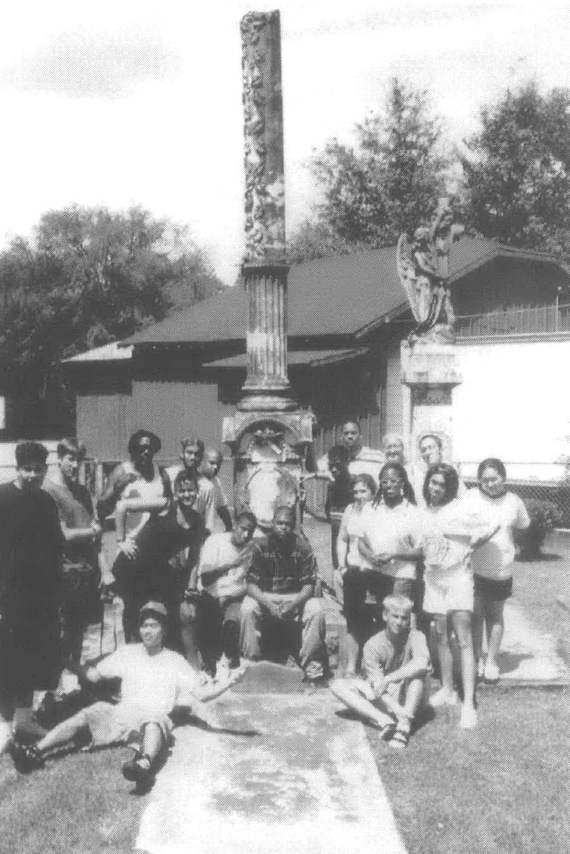
When non-Confederates are recognized in public places, it changes how people think. In 1997, these high school students from Boston visited John Prentiss Matthews' grave and were moved by it. "I was really surprised to learn there were white people like him in the South just after the Civil War," wrote one. (Photo by James Loewen)
Nevertheless, the Southern landscape still leaves out many other true heroes: those white Southerners who, in every era, worked for fairness for all. Samuel Worcester, missionary to the Cherokees, jailed by the governor of Georgia in the 1830s … Elizabeth Van Lew, abolitionist and Union spy in Richmond in the 1860s … John Prentiss Matthews, Jr., anti-racist postmaster of Carrollton, Mississippi, murdered in the 1890s … Helen Keller, socialist and antiracist in the 1920s … Adolphine Terry, Little Rock school supporter in the 1950s … all are omitted from the landscape except Keller, whose radical positions are omitted.
Thus much remains to be done. What person gets the most historical markers in any state? Not Lincoln in Illinois, it turns out, nor Washington in Virginia, but Nathan Bedford Forrest — slave trader, Confederate cavalry leader, and leader of the Ku Klux Klan in Tennessee. He gets a bust in the state capitol, a statue in Memphis, obelisks at his birthplace and at Nathan Bedford Forrest State Park near Camden, and 32 state markers, far more than any other person in any other state in America. No wonder his t-shirts outsell Robert E. Lee's, five to one!
And no wonder young white Southerners never identify with Worcester, Van Lew, Matthews, Keller, Terry, or anyone like them — they've never heard of them!
* Editor's note: The correct spelling of the ship's name is “Clotilda.” In 2019, the Alabama Historical Commission confirmed that remnants of a ship found along the Mobile River were from the Clotilda.
Tags
Southern Exposure
Southern Exposure is a journal that was produced by the Institute for Southern Studies, publisher of Facing South, from 1973 until 2011. It covered a broad range of political and cultural issues in the region, with a special emphasis on investigative journalism and oral history.
